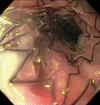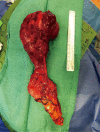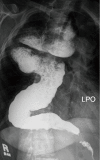Esophagectomy for benign disease
- PMID: 29707359
- PMCID: PMC5906260
- DOI: 10.21037/jtd.2018.01.165
Esophagectomy for benign disease
Abstract
Esophagectomy for benign disease is uncommonly used but it is an important option to consider in those patients who have lost function of this organ. Esophageal resection is, in fact considered as a last resort for benign disease, after multiple failed conservative treatments, when the primary disease is not amenable to other treatments and the esophagus has become non-functional leading to very poor quality of life. The indications for esophagectomy for benign diseases can be divided into three major categories: obstruction, perforation and dysmotility. The process leading to organ failure and the need for resection for each specific disease will be discussed in an attempt to provide guidance as to when an esophagectomy is appropriate.
Keywords: Boerhaave’s syndrome; Esophagectomy; achalasia; benign esophageal disease; benign esophageal neoplasm; caustic ingestion; esophageal perforation; esophageal resection; esophageal stricture; gastroesophageal reflux disease (GERD).
Conflict of interest statement
Conflicts of Interest: The authors have no conflicts of interest to declare.
Figures




References
-
- Carraro EA, Muscarella P. Esophageal replacement for benign disease. Tech Gastrointest Endosc 2015;17:100-6. 10.1016/j.tgie.2015.03.005 - DOI
-
- Zargar SA, Kochhar R, Nagi B, et al. Ingestion of strong corrosive alkalis: spectrum of injury to upper gastrointestinal tract and natural history. Am J Gastroenterol 1992;87:337-41. - PubMed
Publication types
Grants and funding
LinkOut - more resources
Full Text Sources
Other Literature Sources
